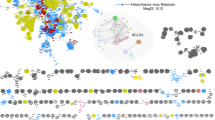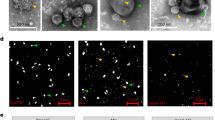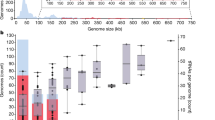Abstract
Viruses are obligate parasites of Eukarya, Archaea and Bacteria. Acanthamoeba polyphaga mimivirus (APMV) is the largest known virus; it grows only in amoeba and is visible under the optical microscope. Mimivirus possesses a 1,185-kilobase double-stranded linear chromosome whose coding capacity is greater than that of numerous bacteria and archaea1,2,3. Here we describe an icosahedral small virus, Sputnik, 50 nm in size, found associated with a new strain of APMV. Sputnik cannot multiply in Acanthamoeba castellanii but grows rapidly, after an eclipse phase, in the giant virus factory found in amoebae co-infected with APMV4. Sputnik growth is deleterious to APMV and results in the production of abortive forms and abnormal capsid assembly of the host virus. The Sputnik genome is an 18.343-kilobase circular double-stranded DNA and contains genes that are linked to viruses infecting each of the three domains of life Eukarya, Archaea and Bacteria. Of the 21 predicted protein-coding genes, eight encode proteins with detectable homologues, including three proteins apparently derived from APMV, a homologue of an archaeal virus integrase, a predicted primase–helicase, a packaging ATPase with homologues in bacteriophages and eukaryotic viruses, a distant homologue of bacterial insertion sequence transposase DNA-binding subunit, and a Zn-ribbon protein. The closest homologues of the last four of these proteins were detected in the Global Ocean Survey environmental data set5, suggesting that Sputnik represents a currently unknown family of viruses. Considering its functional analogy with bacteriophages, we classify this virus as a virophage. The virophage could be a vehicle mediating lateral gene transfer between giant viruses.
This is a preview of subscription content, access via your institution
Access options
Subscribe to this journal
Receive 51 print issues and online access
$199.00 per year
only $3.90 per issue
Buy this article
- Purchase on Springer Link
- Instant access to full article PDF
Prices may be subject to local taxes which are calculated during checkout



Similar content being viewed by others
Accession codes
Primary accessions
GenBank/EMBL/DDBJ
Data deposits
The virophage genome has been deposited in GenBank under accession number EU606015. The Acanthamoeba castellanii mamavirus genes with homologues found in the Sputnik genome have been deposited in GenBank under accession numbers EU827539, EU827540 and EU827541.
References
Raoult, D. et al. The 1.2-megabase genome sequence of Mimivirus. Science 306, 1344–1350 (2004)
La Scola, B. et al. A giant virus in amoebae. Science 299, 2033 (2003)
Koonin, E. V. Virology: Gulliver among the Lilliputians. Curr. Biol. 15, R167–R169 (2005)
Suzan-Monti, M., La Scola, B., Barrassi, L., Espinosa, L. & Raoult, D. Ultrastructural characterization of the giant volcano-like virus factory of Acanthamoeba polyphaga Mimivirus . PLoS ONE 2, e328 (2007)
Rusch, D. B. et al. The Sorcerer II Global Ocean Sampling expedition: northwest Atlantic through eastern tropical Pacific. PLoS Biol. 5, e77 (2007)
Raoult, D. & Forterre, P. Redefining viruses: lessons from Mimivirus. Nature Rev. Microbiol. 6, 315–319 (2008)
Rasmussen, M., Jacobsson, M. & Bjorck, L. Genome-based identification and analysis of collagen-related structural motifs in bacterial and viral proteins. J. Biol. Chem. 278, 32313–32316 (2003)
Williamson, S. J. et al. The Sorcerer II Global Ocean Sampling Expedition: metagenomic characterization of viruses within aquatic microbial samples. PLoS ONE 3, e1456 (2008)
Iyer, L. M., Makarova, K. S., Koonin, E. V. & Aravind, L. Comparative genomics of the FtsK–HerA superfamily of pumping ATPases: implications for the origins of chromosome segregation, cell division and viral capsid packaging. Nucleic Acids Res. 32, 5260–5279 (2004)
De Silva, F. S. & Moss, B. Origin-independent plasmid replication occurs in vaccinia virus cytoplasmic factories and requires all five known poxvirus replication factors. Virol. J. 2 10.1186/1743-422X-2-23 (2005)
Oliveira, S. & Costa, J. V. Replication of transfected plasmid DNA by cells infected with African swine fever virus. Virology 207, 392–399 (1995)
Filee, J., Siguier, P. & Chandler, M. I am what I eat and I eat what I am: acquisition of bacterial genes by giant viruses. Trends Genet. 23, 10–15 (2007)
Moreira, D. & Brochier-Armanet, C. Giant viruses, giant chimeras: the multiple evolutionary histories of Mimivirus genes. BMC Evol. Biol. 8 10.1186/1471-2148-8-12 (2008)
Koonin, E. V., Senkevich, T. G. & Dolja, V. V. The ancient Virus World and evolution of cells. Biol. Direct 1 10.1186/1745-6150-1-29 (2006)
Fauquet, C. M., Mayo, M. A., Maniloff, J., Desselberger, U., Ball, L. A. (eds) Virus Taxonomy (Eighth Report of the International Committee on Taxonomy of Viruses) 1163–1169 (Elsevier, London, 2005)
La Scola, B., Barrassi, L. & Raoult, D. Isolation of new fastidious α-Proteobacteria and Afipia felis from hospital water supplies by direct plating and amoebal co-culture procedures. FEMS Microbiol. Ecol. 34, 129–137 (2000)
Margulies, M. et al. Genome sequencing in microfabricated high-density picolitre reactors. Nature 437, 376–380 (2005)
Lukashin, A. V. & Borodovsky, M. GeneMark.hmm: new solutions for gene finding. Nucleic Acids Res. 26, 1107–1115 (1998)
Katoh, K., Misawa, K., Kuma, K. & Miyata, T. MAFFT: a novel method for rapid multiple sequence alignment based on fast Fourier transform. Nucleic Acids Res. 30, 3059–3066 (2002)
Edgar, R. C. MUSCLE: multiple sequence alignment with high accuracy and high throughput. Nucleic Acids Res. 32, 1792–1797 (2004)
Tamura, K., Dudley, J., Nei, M. & Kumar, S. MEGA4: Molecular Evolutionary Genetics Analysis (MEGA) software version 4.0. Mol. Biol. Evol. 24, 1596–1599 (2007)
Jobb, G., von Haeseler, A. & Strimmer, K. TREEFINDER: a powerful graphical analysis environment for molecular phylogenetics. BMC Evol. Biol. 4 10.1186/1471-2148-4-18 (2004)
Kowalczewska, M. & Raoult, D. Advances in Tropheryma whipplei research: the rush to find biomarkers for Whipple’s disease. Future Microbiol. 2, 631–642 (2007)
Altschul, S. F. et al. Gapped BLAST and PSI-BLAST: a new generation of protein database search programs. Nucleic Acids Res. 25, 3389–3402 (1997)
Finn, R. D. et al. Pfam: clans, web tools and services. Nucleic Acids Res. 34, D247–D251 (2006)
Letunic, I. et al. SMART 4.0: towards genomic data integration. Nucleic Acids Res. 32, D142–D144 (2004)
Ghai, R., Hain, T. & Chakraborty, T. GenomeViz: visualizing microbial genomes. BMC Bioinformatics 5 10.1186/1471-2105-5-198 (2004)
Acknowledgements
We thank X. de Lamballerie, S. Azza, P. de Clocquement, L. Espinosa, B. Campagna, N. Aldrovandi, V. Brice, A. Bernard, C. Ivars, B. Giumelli and Y. Wolf for expert assistance. This work was funded by the Centre National de la Recherche Scientifique (CNRS, crédits récurrents). I.P. is funded by a CIFFRE fellowship, E.K. is supported by the Intramural Research Program of the National Institutes of Health, National Library of Medicine, and P.F. is funded by the Institut Universitaire de France.
Author contributions D.R. and B.L.S. supervised the project and wrote the manuscript. C.D., P.F. and E.K. contributed to sequence analysis, interpretation of the results and writing of the manuscript. I.P. isolated the virus. M.S.-M. contributed to viral cycle analysis, interpretation of the results and writing of the manuscript. M.M. provided water samples. L.B. conducted the viral cycle experiment. C.R. and G.F. sequenced the genome.
Author information
Authors and Affiliations
Corresponding author
Supplementary information
Supplementary Information 1
The file contains Supplementary Figures 1 -13, Supplementary Tables 1 - 4, Supplementary Methods, and Supplementary Results along with additional references. (PDF 708 kb)
Rights and permissions
About this article
Cite this article
La Scola, B., Desnues, C., Pagnier, I. et al. The virophage as a unique parasite of the giant mimivirus. Nature 455, 100–104 (2008). https://doi.org/10.1038/nature07218
Received:
Accepted:
Published:
Issue Date:
DOI: https://doi.org/10.1038/nature07218
This article is cited by
-
Incomplete tricarboxylic acid cycle and proton gradient in Pandoravirus massiliensis: is it still a virus?
The ISME Journal (2022)
-
Detection of Mimivirus from respiratory samples in tuberculosis-suspected patients
Scientific Reports (2022)
-
Giant virus biology and diversity in the era of genome-resolved metagenomics
Nature Reviews Microbiology (2022)
-
Virtual 2D mapping of the viral proteome reveals host-specific modality distribution of molecular weight and isoelectric point
Scientific Reports (2021)
-
The evolution of cheating in viruses
Nature Communications (2021)
Comments
By submitting a comment you agree to abide by our Terms and Community Guidelines. If you find something abusive or that does not comply with our terms or guidelines please flag it as inappropriate.



